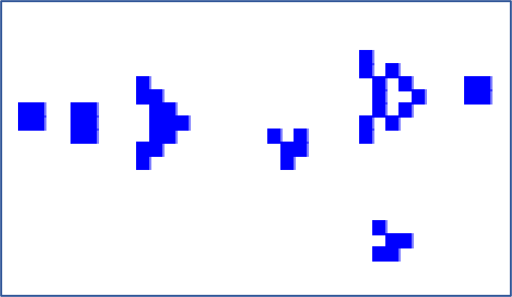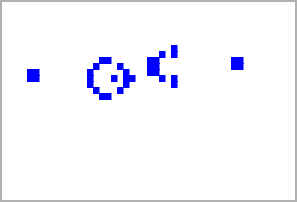Clean Code C# Coding Kata - Conway's Game of Life

Conway’s Game of Life is a very simple game. I’m sure I can implement it in an hour with C#. At least that’s what I thought at first. But the implementation is supposed to be clean code, and I also wanted to have a graphical display. That’s not so easy after all…
Starting point for this article
Last week I participated in a Coding Retreat. We met with 20 people who wanted to grow at this retreat. There were six 45 minute sessions. For each session we were split up into different teams of two. In each session, we had the task of programming the game Conway’s Game of Life. However, the goal was not to have a finished game at the end, instead the goal was to practice TDD and develop clean code.
The coding retreat was a lot of fun. I met new people, got to know people better, and learned different perspectives and approaches.
After the event, I experimented some more. Especially concerning the graphical output and clean code. This is the result:

I describe the essential parts of the code in this post. The whole code can be found on Github.
A cell of the game
The rules for Conway’s Game of Life can be found on Wikipedia, so I won’t write them here.
The class Cell represents a cell in the Game of Life:
public class Cell
{
private bool _willBeAlive;
public bool IsAlive { get; set; }
public void CalculateNextState(int livingNeighbors)
{
_willBeAlive = WillBeAlive(livingNeighbors);
}
public void SwitchToNextState()
{
IsAlive = _willBeAlive;
}
private bool WillBeAlive(int livingNeighbors)
{
// Code according to rules of Conways Game of Life
// ...
}
}
This class cares whether a cell is currently alive or not (IsAlive), it calculates the next state this cell will have (CalculateNextState), and it can change the current state accordingly (SwitchToNextState).
Position of a cell
The position of a cell is determined by two coordinates. I have defined a record CellPosition for this purpose:
public record CellPosition(int Row, int Column);
The grid
The Grid class manages all cells and can determine the neighbors of a cell position:
public class Grid
{
private readonly Cell[,] _cells;
private readonly int _rowCount;
private readonly int _columnCount;
public Grid(int rowCount, int columnCount)
{
// Initializes all private fields
// ...
}
public Cell CellAt(CellPosition cellPosition) => _cells[cellPosition.Row, cellPosition.Column];
public IEnumerable<CellPosition> AllCellPositions()
{
for (int row = 0; row < _rowCount; row++)
for (int column = 0; column < _columnCount; column++)
yield return new CellPosition(row, column);
}
public List<Cell> NeighborsOfCellAt(CellPosition cellPosition)
{
var neighbors = new List<Cell>();
// Determines the maximal eight neighbors of cellPosition
// ...
return neighbors;
}
}
The Game
Now the game itself is missing. For this there is the Game class.
public class Game
{
private readonly Grid _grid;
private readonly IRenderer _renderer;
public Game(int rowCount, int columnCount, IEnumerable<CellPosition> seed, IRenderer renderer)
{
_grid = new Grid(rowCount, columnCount);
foreach (var cellPosition in seed)
_grid.CellAt(cellPosition).IsAlive = true;
_renderer = renderer;
}
public void Run(int iterationCount)
{
ShowState();
for (int i = 0; i < iterationCount; i++)
{
CalculateNextIteration();
ShowState();
}
}
private void CalculateNextIteration()
{
foreach (var cellPosition in _grid.AllCellPositions())
{
int livingNeighbors = _grid.NeighborsOfCellAt(cellPosition).Count(neighborCell => neighborCell.IsAlive);
_grid.CellAt(cellPosition).CalculateNextState(livingNeighbors);
}
foreach (var cellId in _grid.AllCellPositions())
{
_grid.CellAt(cellId).SwitchToNextState();
}
}
private void ShowState()
{
foreach (var cellPosition in _grid.AllCellPositions())
{
_renderer.SetCellState(cellPosition, _grid.CellAt(cellPosition).IsAlive);
}
_renderer.ShowState();
}
}
The central method is the Run method, with which a given number of iterations is calculated and displayed. For this internally the Grid and the Cell classes are used. The display is done by an IRenderer interface, which was passed to the constructor.
Display on the screen
The display of the game is done under the hood with WPF. Because using WPF directly is a bit complicated, I use my Nuget package Woopec for the display here.
First, a new Visual Studio project type is defined via this command:
dotnet new --install Woopec.Templates
After that, you can create a new project of type “Woopec WPF Project” in Visual Studio. The implementation of the Renderer class is relatively simple:
using Woopec.Core;
namespace GameOfLife
{
internal class Renderer : IRenderer
{
private readonly Figure[,] _cells;
public Renderer(int rowCount, int columnCount, int cellSize)
{
Shape shape = CreateCellShape(cellSize);
_cells = CreateAllCells(rowCount, columnCount, cellSize, shape);
}
public void SetCellState(CellPosition cellId, bool isVisible)
{
var figure = _cells[cellId.Row, cellId.Column];
figure.IsVisible = isVisible;
}
public void ShowState()
{
Thread.Sleep(10);
}
private static Shape CreateCellShape(int cellSize)
{
var coor = cellSize / 2.0;
var polygon = new List<Vec2D>() { (-coor, -coor), (-coor, coor), (coor, coor), (coor, -coor)};
return new Shape(polygon);
}
private static Figure[,] CreateAllCells(int rowCount, int columnCount, int cellSize, Shape shape)
{
var cells = new Figure[rowCount, columnCount];
for (int row = 0; row < rowCount; row++)
for (int column = 0; column < columnCount; column++)
cells[row, column] = CreateFigureAt(row, column, rowCount, columnCount, cellSize, shape);
return cells;
}
private static Figure CreateFigureAt(int row, int column, int rowCount, int columnCount, int cellSize, Shape shape)
{
var figure = new Figure() { Shape = shape, Color = Colors.Blue };
figure.SetPosition((column - columnCount / 2) * cellSize, (rowCount / 2 - row) * cellSize);
return figure;
}
}
}
First, a Woopec shape representing a suitably sized square is created (method CreateCellShape). Then, for each cell, a Woopec figure with this shape is placed at the appropriate screen position (method CreateAllCells). These Woopec figures can be made visible or invisible. Initially they are not visible. Method SetCellState is used to make a single cell visible or invisible on the screen. The method ShowState makes a small pause, so that the user can look at the current state after an iteration of the game.
Main-Method
Method WoopecMain in Program.cs puts all parts together and starts the game:
using GameOfLife;
using Woopec.Core;
internal class Program
{
public static void WoopecMain()
{
int rowCount = 120;
int columnCount = 120;
var renderer = new Renderer(rowCount, columnCount, 6);
string gosperGilderGun = @"
.........................X
.......................X.X
.............XX......XX............XX
............X...X....XX............XX
.XX........X.....X...XX
.XX........X...X.XX....X.X
...........X.....X.......X
............X...X........
.............XX.";
var seed = AliveCellPositionsOfSeed(gosperGilderGun);
var game = new Game(rowCount, columnCount, seed, renderer);
game.Run(iterationCount: 1000);
Screen.Default.Bye();
}
private static IEnumerable<CellPosition> AliveCellPositionsOfSeed(string seedString)
{
// Converts a string into a list of all CellPositions of living cells
// ...
}
}
And cut
Although this Game of Life Kata looks so simple at first, you can spend a lot of time on it. Actually, at the beginning of this post, I thought that the code was good and done. But even while writing this post, I still changed a few things. And even now I still notice parts of the code that could be changed. For example, I could change the IRenderer interface to have only one method (instead of two) with a parameter that contains all visible cells of the next iteration. This would have advantages and disadvantages…
But at some point you have to say: I have done and learned enough for today. That’s why I leave it at that. I think I practiced a few things and did them well. There is always room for improvement. But this is (for now) good enough for me.
Comment on this post ❤️
I am very interested in what readers think of this post and what ideas or questions they have. The easiest way to do this is to respond to my anonymous survey.